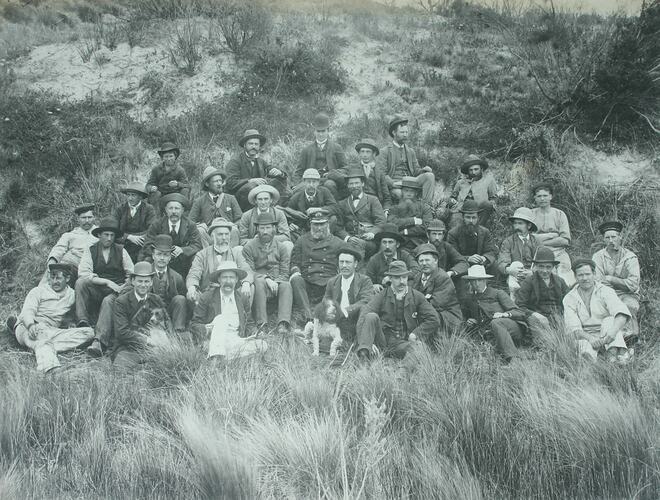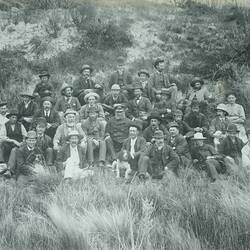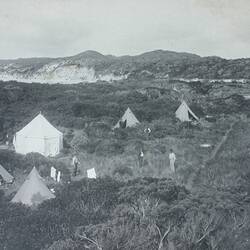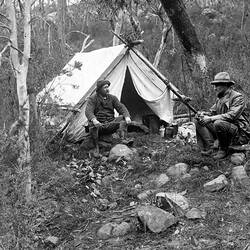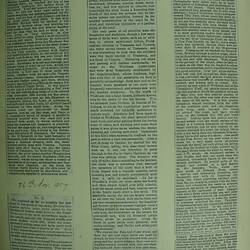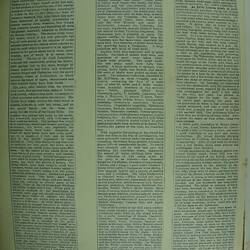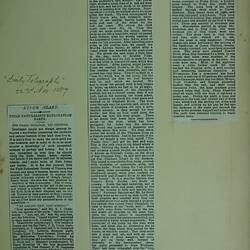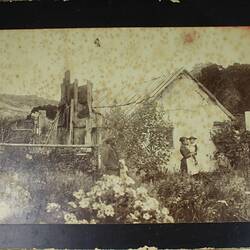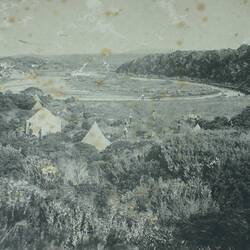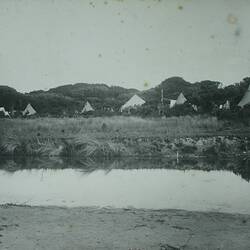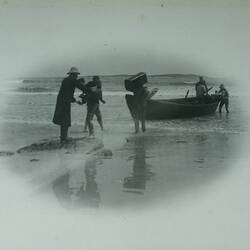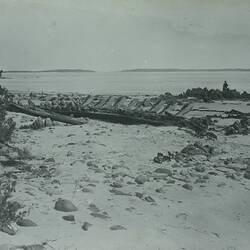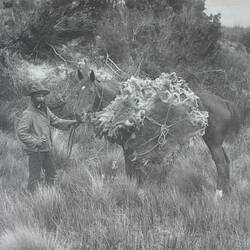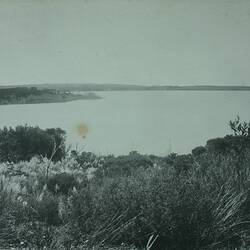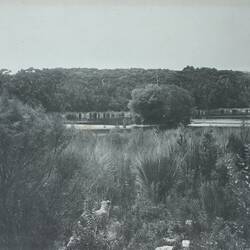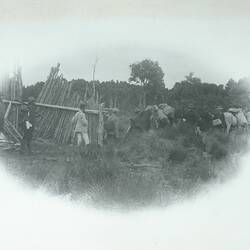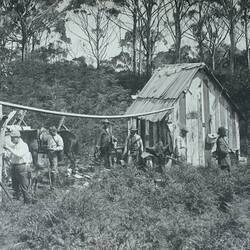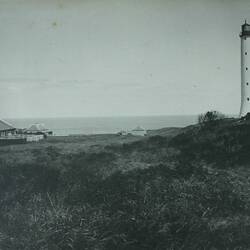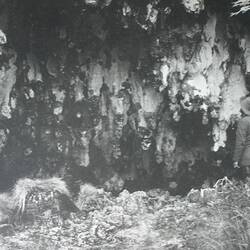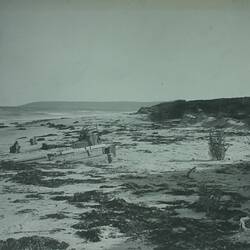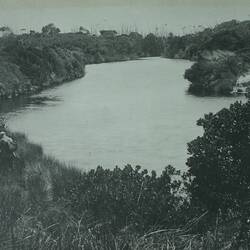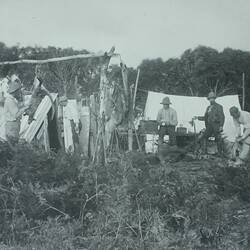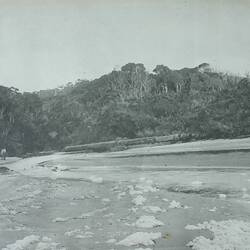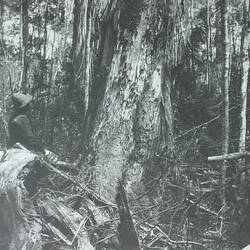Transcribed from The Age, 24th November, 1887
THE FIELD NATURALISTS AT KING'S ISLAND
The party which, under the auspices of the Field Naturalists' Society, started from Port Melbourne for King's Island on the 2nd inst., for the purposes of exploring one of the smaller members of the group which once, according to the writher in the Cornhill Magazine, were all united to Southern Asia, from which they have been disallowed by mighty convulsions of nature, tearing Java, Sumatra, New Guinea and Australia asunder and separating all from the present mainland, returned to Melbourne on Monday evening. The theory of the Cornhill Magazine writer, which is not only plausible but logical, rests mainly on the remains of Asian animals found on the islands above referred to, the main object to arrive at tis an approximation to the period about which these catastrophes, one of which is of recent date occurred. The trip of the Field Naturalist, although not conclusively setting the matter, adds another link to the chain wrought by former inquirers and which may eventually connect Bengal and Timbuctu with the snowy mountain ridges of Switzerland, in whose caverns the bones of tigers, rhinoceroses and other tropical fauna have been found.
The party, after landing from the steamer Lady Loch, first pitched their camp at Yellow Rock rivulet, whence they made excursions to collect specimens and explore the country. The Yellow Rock Creek, whence the fresh water is derived is brown in colour but sweet, and so on the sandy beach, not far from the camp , lies the wreak of the Ocean Bride. The weather was stormy and rainy at the outset by afterwards improved, until it became all that could be desired. The herbage was found to be luxuriant, trefoil and lucerne growing in abundance, but weeds, and especially the poisonous tares were rank. Hundreds of acres of spear grass were met with growing to a height of 3 feet, and so dense that it was almost impossible to walk through it. Very little timber of any size is to be found on the east coast, but down at the south end of the island some large trees were seen. In the centre of the island there are new large tracts of nice open country, and running streams of food water. Several attempts have been made to utilise the plain for pastoral purposes, but each has proved a failure. The sheep which have been recently tried were merinos, whilst the pasture is more suited to long wool. Cattle fatten well but young calves are difficult to rear. Horses and pigs do remarkably well. The latter have been allowed to wander to large, and now herds of them are roaming in several parts of the island. Some of the old boars near Wickham are said to weight over 4 oz. When pork ore bacon is required by the inhabitants the medium sized pigs are caught and sty fed for about eight weeks to correct the flavour acquired from the rotten kelp on which the feed in a sealed state. In some places scrub is so dense as to compel travellers to follow the beach, and all around the island the shore was found to be littered with remains of wrecked vassals. Several human bones, supposes to have drifted ashore from the French convict ship Nova, wreaked about 40 years ago, were found by a member of the party. The population of the island was found to be easily counted, being composed of four hunters and the lighthouse keepers, and their assistants, although 11 males, 7 females, 21 children. Most of these children were born on the place, and neither parent nor children had seen a doctor until the appearance of Dr. Llewellyn with the party. The Currie Harbour and Cape Wickham lighthouses were found to be in a most satisfactory condition. The water at the Currie Harbour jetty is 7 feet deep, and the anchorage 8 feet 6 inches at low water.
Having said so much about the island, reference must be made to the objects of the clubs visit. The animals found most numerous were brush kangaroos and fur wallabies, tiger cats, larger than the Victorian ones, being plentiful, and requiring the inhabitants to watch their poultry very closely, as one of those animals killed 25 fowls at Currie Harbour in a single evening. The little native cats and native bears found in Victoria are absent, as are also the larger kinds of kangaroo. Two varieties of opossums are found, the ring tail and brush tail, the former having a black face. A very pretty furred rat and also field mice with long fur were found, but the snakes prevent them multiplying very fast. Of the birds many of the water foul are said to closely resemble Victorian kinds through the magpie, laughing jackass and emus were nowhere seen. The Tasmanian sooty crow shrike was very plentiful all along the coast where they share with gulls and water fowl and insects amongst, the rotten kelp. The pretty hooded dottrell seldom seen in Victoria existed in large numbers along the beach. None of the Victorian parrots were seen on the island, though three kinds our cockatoos were found - the gang an, sulphured crested and black. Three kinds of robins were found - the dusky, the flame breasted and the rose breasted, all fairly numerous. The honey eaters seen were nearly all of Tasmanian origin, the wattle bird, with pendulous wattles over an inch long, is much larger than the Victorian. Six or seven of the smaller kinds were found. But only the New Holland and spine bill honey eaters resemble the Victorian. The sea eagle, eaglehawks, and six kinds of hawks are similar to their Victorian congeners. The Tasmanian lory is plentiful in parts. The superb warbler is much brighter that the Victorian, and has more colour especially the male bird. Two varieties of plover were found the spurning being a Tasmanian. A large collection was made of small birds.
Reptiles were very numerous and in great variety. Six kinds of snakes were seen and specimens of most were taken alive, lizards were plentiful. The large cyclodus and many small ones have been secured. A large collection of sponges, comprising thirty kinds were formed and about 100 sorts of shells were picked up along the beach. The botanical collection, classified by Mr. M'Kibbon, is most valuable and extensive, embracing the flora of a coast line of over 45 miles and 8 miles inland. Some beautiful members of orchids were taken amongst other being Pterostylis curts, P. barbata, Caladinia, latitolia, C. Menziesli, C. carnes, C. alats, Thelymiltra, longifolia (form white), Corysanthus, fimbritata, cryptosylis longifolis, Sprengelia incarnata, Bankisa marginate, Comersperma valubile, Geranium Australe, Correa speciosa, Schizaea bifida, Ophioglossum vuigatum, Acaria Lougitolia &c. as this section is very large, a more complete report cannot be given until plants have been submitted to Baron Von Mueller, the patron of the club for examination.
With regard to the geology of the island but little was done in the way of investigation, the most noticeable outer crop under the sandy beach extending far inland being granite, forming in places cliffs of considerable height. No fossils were obtained, and in only one part was anything like limestone found, apparently the deposit of water trickling from above the collection of live stock made by the party is as follows; one Bennett's Kangaroo, 2 wallabies, 10 snakes, 2 pied oyster catchers, 5 young silver gulls, 1 Tasmanian crow shrike, 4 blue tongued lizards, and a variety of smaller ones and 4 echidnas. The other kinds noted or obtained were- White bellied sea eagles, spotted owl, white owl, three kinds of swallow, sacred kingfisher, allied diamond bird, Tasmanian graucuius, olivaceous thickhead, Tasmanian fantail, Selby's shrike thrush, three kinds of cuckoo, yellow bellied parakeet, rufous headed grass warbler, sombre coloured sericornis, Tasmanian acanthiser, ground lark or Australian pipet, six varieties of honey eaters, grey bucked zosterops, Caspian tern and Bass Strait tern.
One of the features of the visit was a wallaby hunt which afforded good sport. Among the excursions made while on the island was one by a party consisting of Messrs. Campbell, Chandler, Cornwall, Chisholm, Frost, le Souef, Sayer, Wood, Professor Spencer and others to the east coast, with a hunt names Graves, as guide. They started on Monday the 7th and after travelling 20 miles pitched ten at Bertie's camp for the night. On the following day Spencer River, 17 miles distant on Sea Elephant Bay, was reached. Very little collecting was done, as the weather was bad, and the country bare of results. On Wednesday Mr. Wood assistant to Mr. Hart, photographer, took photos of several places of interest. Here a Blackwood forest and also one of blue gum were passed through by very little animal life was seen. Professor Spencer and Mr. La Souef visited a place called 'The Wall' but found nothing of interest. The former took sketches of the scenery. Five echidnas were taken alive, but one subsequently escaped. As provisions ran short a return journey was commenced. On Thursday Bertie's camp was made where two of the party remained collection. On Friday 11th, Cape Graves hut on the way, and the whole party hospitably entertained by Mr. Garraway, the lighthouse keeper. On Saturday the party returned to the main camp at Yellow Rock.
The second party consisting of Messrs Dixson, Dombrian, Hatton, Hughes, Keartland and M'Kibbon left for Currie Harbour at 9 am on the 7th with hunter Henry Scott for a guide. After passing the wreck of the Ocean Bride a course was taken through the hills east of Whistler Point, the journey being a very rough one rain falling nearly all the way to Porky lagoon, where camp was pitched. On the way the hunter's dogs which accompanied the party killed several wallabies, so all had fresh meat for ten. A fairly good collection of various kinds was made on the road. Birds, animals birds eggs, shells, sponges and botanical specimens, &c, added materially to the load. At Porky Lagoon plenty of good water was found, alter drying wet clothes and blankets all turned in thoroughly tired after 13 miles tramp over very rough country. On the way many miles had to be forced through a species of wild tobacco plant common in Tasmania. It grows just as freely in hills and valleys. On Tuesday, 8th a successful morning was spent around camp, and come of the best birds taken during the trip were secured. At 2pm another start was made for Currie Harbour, many nice fresh streams being passed on the way, and fine open country. Currie Harbour was reached at 5pm. Mr Buckpitt, the lighthouse keeper, soon made all things pleasant, and the evening was spent in a visit to the lighthouse, a preserving specimens. On Wednesday some of the party went to the Ettrick River, and on the way found the eggs of the Pacific gull, black and red oystercatchers, silver gull and hooded dotreil, besides securing some of the old bird. The others were taken tot some small islands in the harbour in a boat by Mr, Buckpitt and an assistant, and a few marine curios were found. Here the skins of several enormous tiger cats were obtained. On Thursday, the homeward march was commenced, with the assistance of an additional horse, supplied by Mr. Buckpitt, who accompanied the party a few miles on the way and camp was pitched at Porky Lagoon for the night. On resuming our march next morning the party had not preceded far when a fine porcupine was caught uninjured, and also a crow shrike which had probably been injured in a fight with another bird. One gentleman killed no fewer than six snakes in a many miles. After a pause for lunch at Pass River, camp was soon reached.
A third party consisting of Messrs, Campbell, Jun, Coles, Deasey, Lan and Dr. Llewellyn made a trip to Whistler's Point, and made a good collection of sea fowl and marine productions. Mr Sweet directed dredging operations at Wickham, but the coast is bare of marine life. After 30 tries with the dredges only broken shells, some polyzoa and gasteropods were obtained. Several members of the different parties proceeded further south, where they say the remains of the wreck of the British Admiral, and found the anchor and several other portions which a recently washed ashore. The marble monument erected to the memory of Mr Nicholson son of the late Hon. Win Nicholson, who along with 78 others, perished in the wreck of the British Admiral, on 23rd may 1874 aged 25 years, is still standing, but the iron portion of the frame is nearly corroded through and the woodwork has completely disappeared. The tablet in memory of those were drowned in the Catarique is still standing, but so corroded as to render the inscription quite illegible. This might have been easily avoided, as the hunters on the island state that they would have given it a coat of tat on many occasions, if they could only get it left for them at the lighthouse.
The last few days in camp were spent in shore excursions inland and in packing specimens. On Saturday evening 19th, the Lady Loch was soon off New Year Islands, where she lay all night. Early on Sunday morning Captain Anderson came ashore and desired all hand to strike camp at once, as the opportunity was favourable, and delay would be very inconvenient. During the afternoon tow parties visited New Year Islands, but found very little interest beyond one new fern and a few gulls' eggs. The mutton birds had commenced to burrow, but only a few had laid. On the east side of the north island cabbages, parsley and garden flowers, such as stocks are growing wild. At 4pm on the 21st inst a new start was made by the lady Loch from New Years Islands for Apollo Bay, where a party of gentlemen had been left on Saturday, amongst them being Mr. Wilson engineer of ports and harbours, Mr Steel, inspector-general of public for medical treatment. Messrs. Wilson and Steel had mad an inspection of Apollo Bay jetty, part of which recently blown way in a gale. Williamstown was reached at 8.45pm.
More Information
-
Keywords
-
Authors
-
Contributors
-
Article types
